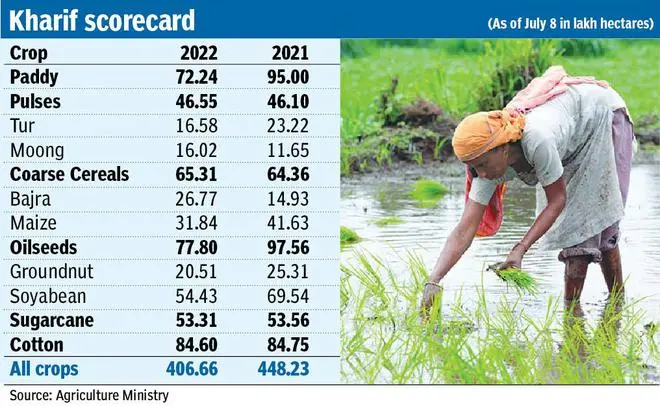The total area under kharif crops dropped 17 per cent this week much against expectations of sowing operation gaining momentum as seen last week after the monsoon covered the entire country.
s
However, experts see the pace of sowing picking up in the remaining three weeks, especially in States where normal rainfall has been predicted for the month, the wettest in the June-September monsoon season.

As many as 127.94 lakh hectares (lh) were brought under cultivation during July 2-8 against 153.81 lh in the year-ago period, according to a weekly update released by the Agriculture Ministry on Friday. Farmers had planted crops on 138.2 lh (up 25 per cent from a year ago) during June 25-July 1. The overall acreage under kharif crops was 406.66 lh as of Friday against 448.23 lh in the year-ago period, down 9.3 per cent.
Area under paddy down
The area under paddy continued to be on the lower side. It was 72.24 lh as of July 8 against 95 lh in the corresponding period in 2021 and 126.1 lh in 2020. Except for Uttar Pradesh, all the other paddy growing States have reported lower acreage.
The total acreage under pulses has increased 1 per cent to 46.55 lh from 46.10 lh.
Oilseeds sowing has dropped by 20.3 per cent to 77.80 lh from 97.56 lh. While soyabean is reported to have declined by 22 per cent to 54.43 lh, the area under groundnut was down 19 per cent to 20.51 lh. The acreage under coarse cereals has increased marginally to 65.31 lh from 64.36 lh. The area under maize has, however, declined 23.5 per cent to 31.84 lh.
Cotton acreage stood at 84.6 lh until Friday, a notch below the 84.75 lh a year ago. Similarly, jute and mesta sowing was down marginally at 6.86 lh from 6.91 lh, and that of sugarcane stood at 53.31lh from 53.56 lh.
Rainfall distribution
Last year as much as 80 per cent of the normal area was covered by the end of July, against less than 40 per cent so far this year. The normal area under kharif crops is about 1,070 lh. “It is possible to cover another 40 per cent area in the next three weeks if the distribution of rainfall is widespread and not the quantity,” said an official.
The India Meteorological Department (IMD) has predicted normal rainfall in July in most of the States barring a few in the eastern region. However, if low pressure systems develop, they can make up the deficiency in rainfall in those states, too.
The country as a whole has received 2 per cent above normal rainfall between June 1 and July 8, the first time on the positive side this season. While rains in the east and north-east, and southern regions have been 4 per cent and 13 per cent more than normal, respectively, deficiency in the north-west and central regions has narrowed down to near normal levels now.
Against 20 per cent deficiency in the north-west region, and 33 per cent in central India until June 29, the deficiency now is 3 per cent and 4 per cent, respectively, for both the regions. Agriculture scientists have expressed concern over excess rains in a short period and then a dry spell for a longer period. Such a phenomenon is not good for the crop. For instance, the north-west region was 77 per cent deficient until June 15, 33 per cent below normal as of June 19, 1 per cent above normal as of June 24 and 20 per cent deficient as of June 29.
However, sowing in Uttar Pradesh, one of the high rainfall deficiency States this season, has not been affected much as farmers have planted crops on 35.8 lh area so far against 36.4 lh in the year-ago period. Rainfall in the State was 56 per cent below normal until July 8. As many as 28 States and union territories have received normal or more rainfall, so far. But, 22 per cent of the geographical area in the country is been deficient, IMD data show.





Comments
Comments have to be in English, and in full sentences. They cannot be abusive or personal. Please abide by our community guidelines for posting your comments.
We have migrated to a new commenting platform. If you are already a registered user of TheHindu Businessline and logged in, you may continue to engage with our articles. If you do not have an account please register and login to post comments. Users can access their older comments by logging into their accounts on Vuukle.